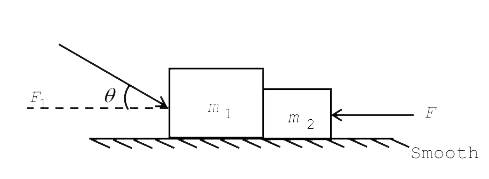The system shown in the figure can move on a smooth surface. They are initially compressed by 6cm and then released, then choose the correct options.

(a) The system performs, SHM with time period π10s
(b) The block of mass 3kg perform SHM with amplitude 4cm
( c) The block of mass 6kg will have maximum momentum of 2.40kg−m/s
(d) The time periods of two blocks are in the ratio of 1:√2
The correct Answer is:A
μ=Reducedmass
=m1m2(m1)+(m2)=2kg
T=2π√μk
=2π√2800=π10s=T3=T6
A∝1m
∴A3A6=63=21
∴A3=4cm and A6=2cm
∴(P6)max=m6(v6)max
=m6(ωA6)
=(6)(2ππ/10)(2×10−2)
2.4kg−m/s
∴ The correct option are (a, b, c).
Topper's Solved these Questions
- SIMPLE HARMONIC MOTIONBOOK - DC PANDEYCHAPTER - SIMPLE HARMONIC MOTIONEXERCISE - Example Type 13
3 Videos
- SIMPLE HARMONIC MOTIONBOOK - DC PANDEYCHAPTER - SIMPLE HARMONIC MOTIONEXERCISE - Miscellaneous Examples
8 Videos
- SIMPLE HARMONIC MOTIONBOOK - DC PANDEYCHAPTER - SIMPLE HARMONIC MOTIONEXERCISE - Example Type 11
2 Videos
- SEMICONDUCTORS AND ELECTRONIC DEVICESBOOK - DC PANDEYCHAPTER - SEMICONDUCTORS AND ELECTRONIC DEVICESEXERCISE - More than One Option is Correct
3 Videos
- SOLVD PAPERS 2017 NEET, AIIMS & JIPMERBOOK - DC PANDEYCHAPTER - SOLVD PAPERS 2017 NEET, AIIMS & JIPMEREXERCISE - Solved paper 2018(JIPMER)
38 Videos
Similar Questions
The system shown in the figure can move on a smooth surface. The spring is initially compressed by 6cm and then released.Find

(a) time perod
(b) amplitude of 3kg block
(c ) maximum momentum of 6kg block
View SolutionTwo forces are applied on a system of blocks as shown. The block remains in equilibrium on the smooth surface. Then choose the correct option(s).

View Solution
Knowledge Check
The system shown in the figure can move on a smooth surface. The spring is initially compressed by 6 cm and then released.
 Athe particles perform SHM with time period π10secBthe block of mass 3 kg perform SHM with amplitude 4 cmCthe block of mass 6 kg will have maximum momentum 2.40kgm/sDnone of these
Athe particles perform SHM with time period π10secBthe block of mass 3 kg perform SHM with amplitude 4 cmCthe block of mass 6 kg will have maximum momentum 2.40kgm/sDnone of theseA body of mass 8 kg performs S.H.M. of amplitude 60 cm. The restoring force is 120 N, when the displacement is 60 cm. The time period is
A0.628sB1.256sC1.884sD2.512sA horizontal platform with a small block of mass 1 kg kept on it performs vertical SHM of amplitude 1 cm. The block does not lose contact with the platform anywhere. The minimum possible time period of the platform
A0.1 sB0.2 sC0.3 sD0.4 s
Block A of mass m is performing SHM of amplitude a. Another block B of mas m is gently placed on A when it passes through mean position and B sticks to A. Find the time period and amplitude of new SHM.
View SolutionA particle performing linear S.H.M. has maximum velocity of 25 cm/s and maximum acceleration of 100cm/s2. Find the amplitude and period of oscillation. (π=3.142)
View SolutionA body of mass 8 kg performs SHM of amplitude 60 cm. The restoring force is 120N when the displacement is 60 cm. Its acceleration , PE and KE when displacement is 6 cm are
View SolutionA horizontal spring-block system of mass 1kg executes SHM of amplitude 10 cm. When the block is passing through its equilibrium position another mass of 1kg is put on it and the two move together.
View SolutionA particle of mass 2kg executing SHM has amplitude 20cm and time period 1s. Its maximum speed is
View Solution
